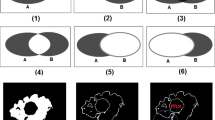Abstract
The research work intends to segregate the lungs area of interest, especially removing the ribs from the X-Ray images for future image analysis and interpretation. The storage and processing of medical data irrespective of the physical location of lab are explored in this research with Cloud computing. Extracting valid information from a medical image is of high importance in the medical arena. The information loss may lead to the misinterpretation of medical image analysis, which in turn can affect the treatment process to be prolonged or can be deviated from the real phase of examination. Evaluating the entropy from the medical images using the multi-level segmentation using the differential evolution technique on the fuzzy parameters applied on the chest X-ray images resulted in the extraction of the rib cages from the image, thus producing an image with the region of lung alone for the diagnostic purposes. The quality of the information obtained has been evaluated based upon the entropic value. The multi-level segmentation applied on the chest X-ray images using the differential evolution accelerated the optimum fuzzy parameters for the multi-level segmentation. The multi-level algorithmic approach with 4 threshold levels applied had resulted in four different thresholding, out of which the optimum threshold value has been chosen by the algorithm to provide the output. The results thus obtained, outperformed the conventional approach of Otsu segmentation and 3-level segmentation. The computational and storage power of cloud added strength to image data processing. The cloud computing facility by Matlab Cloud NVIDIA eased the processing rather than the conventional computing.









Similar content being viewed by others
Data availability
Enquiries about data availability should be directed to the authors.
References
American College of Surgeons (1997) Advanced trauma life support. American College of Surgeons
Driscoll PA, Gwinnutt CL et al (1997) Chest and cardiac trauma. Cambridge textbook of accident and emergency medicine. Cambridge University Press, Cambridge, p 538
Elaziz MA, Oliva D, Ewees AA, Xiong S (2019a) Multi-level thresholding-based grey scale image segmentation using multi-objective multi-verse optimizer. Exp Syst Appl 125:112–129
Elaziz MA, Bhattacharyya S, Lu S (2019b) Swarm selection method for multilevel thresholding image segmentation. Exp Syst Appl 138:112818
Feoktistov V (2006) Differential evolution. Springer optimization and its applications, vol 5. Springer, Boston
Kittler J, Illingworth J (1986) Minimum error thresholding. Pattern Recognit 19(1):56
Krishna Priya R, Thangaraj C, Kesavadas C, Kannan S (2013) Fuzzy entropy based MR brain image segmentation using modified particle swarm optimization. Int J Imaging Syst Technol 23(4):281–288
Krishna Priya R, Thangaraj C, Kesavadas C, Kannan S (2015) Brain tumours segmentation in mri images using integrated modified PSO-fuzzy approach. Int Arab J Inf Technol 12(6A):89
Leigh-Smith S, Davies G (2003) Tension pneumothorax: eyes may be more diagnostic than ears. Emerg Med J 20:495–496
Leigh-Smith S, Harris T (2005) Tension pneumothorax—time for a re-think? Emerg Med J 22:8–16
Luca AD, Termini S (1972) Definition of a non-probabilistic entropy in the setting of fuzzy sets theory. Inf Contr 20:301–315
Ochoa-Montiel R, Carrasco-Aguilar MA, Sánchez-López C, Albores-Velasco FJ, Morales-López FE, Flores-Pulido L (2017) Images segmentation by using differential evolution with constraints handling. In: 2017 IEEE Latin American conference on computational intelligence (LA-CCI)
Oliva D, Nag S, Elaziz MA, Sarkar U, Hinojosa S (2019) Multilevel thresholding by fuzzy type II sets using evolutionary algorithms. Swarm Evol Comput 51:100591
Otsu N (1979) A threshold selection method for grey level histograms. IEEE Trans Syst Man Cybern SMC 9(1):62–66
Ouyang X et al (2019) Weakly supervised segmentation framework with uncertainty: a study on pneumothorax segmentation in chest X-ray. Medical Image Computing and Computer Assisted Intervention—MICCAI 2019, Cham
Pham TX, Siarry P, Oulhadj H (2019) A multi-objective optimization approach for brain MRI segmentation using fuzzy entropy clustering and region-based active contour methods. Magn Reson Imaging 61:41–65
Rahnamayan S, Tizhoosh H, Salama MMA (2006) Image thresholding using differential evolution, pp 244–249
Sarkar S, Patra GR, Das S (2011) A differential evolution based approach for multilevel image segmentation using minimum cross entropy thresholding. In: Panigrahi BK, Suganthan PN, Das S, Satapathy SC (eds) SEMCCO 2011, Part I. LNCS, vol 7076. Springer, Heidelberg, pp 51–58
Sarkar S, Das S, Chaudhuri SS (2012) Multilevel image thresholding based on tsallis entropy and differential evolution. In: Panigrahi BK, Das S, Suganthan PN, Nanda PK (eds) SEMCCO 2012. LNCS, vol 7677. Springer, Heidelberg, pp 17–24
Sezgin M, Sankur B (2004) Survey over image thresholding techniques and quantitative performance evaluation. J Electron Imaging 13:146–168
Storn R, Price K (1997) Differential evolution—a simple and efficient heuristic for global optimization over continuous spaces. J Global Optim 11:341–359
Taylor AG, Mielke C, Mongan J (2018) Automated detection of moderate and large pneumothorax on frontal chest X-rays using deep convolutional neural networks: a retrospective study. PLoS Med 15(11):e1002697
Watts BL, Howell MA (2001) Tension pneumothorax: a difficult diagnosis. Emerg Med J 18:319–320
Waydhas C, Sauerland S (2007) Pre-hospital pleural decompression and chest tube placement after blunt trauma: A systematic review. Resuscitation 72(1):11–25
Zhao MS, Fu AMN, Yan H (2001) A technique of three level thresholding based on probability partition and fuzzy 3-partition. IEEE Trans Fuzzy Syst 9(3):469–479
Funding
The authors have not disclosed any funding.
Author information
Authors and Affiliations
Corresponding author
Ethics declarations
Competing Interests
The authors have not disclosed any competing interests.
Additional information
Communicated by Meng Joo.
Publisher's Note
Springer Nature remains neutral with regard to jurisdictional claims in published maps and institutional affiliations.
Rights and permissions
About this article
Cite this article
Priya, R.K., Bimani, A.A., Bhupathyraaj, M. et al. Fuzzy-entropic approach on chest X-ray region of interest segmentation-heart position shifting using differential evolution optimization and multi-level segmentation technique with cloud computing. Soft Comput 27, 1639–1650 (2023). https://doi.org/10.1007/s00500-022-07006-x
Accepted:
Published:
Issue Date:
DOI: https://doi.org/10.1007/s00500-022-07006-x




